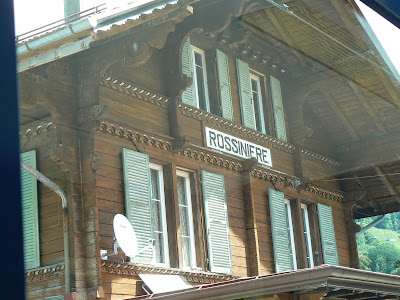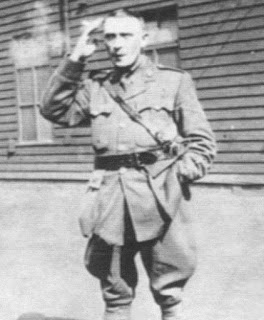It has been a couple of months but we now catch back up with Connie Kirkup and E. Angus Leybourne, and there have been a few changes. Margaret Eason continues their story.
 |
| Rossiniere station, taken from the train, Victoria Oxberry, 2008 |
'Hotel Grand Chalet, Rossinieres, Vaud, (Suisse)
Veuve Haldi, Proprietaire.
Dated June 9. 1916.'
Angus writes:
'My Dear Connie, Now for a letter, instead of being restricted to the usual postcard. You will no doubt have read in The Times of our arrival in Suisse, it certainly was a most extraordinary show. We only got about 12 hours’ notice to leave Gutersloh & proceeded on a long two days trip right through Germany, down the Rhine and on to Constance.'
Perhaps you will have heard of the safe haven that was created in Switzerland for the sick and wounded Prisoners of War of 'all the belligerent States': French, German, Belgium, British, Indian, Serbian, South American, American and Canadian, Russian, the list goes on, of sick and wounded Interned in Switzerland under the Guardianship of the Swiss Government, and organised through the International Committee of the Red Cross, whose headquarters are still in Geneva.
There is a famous quote from the film The Third Man, when Orson Welles's character derides the Swiss, asking what their '500 years of brotherly love and democracy' has produced? And of course, the famous answer he gives, as you will know is, 'the cuckoo clock.' But the clue to the first international humanitarian organisation the Swiss gave to the world, the International Committee of the Red Cross, which Orson, as I thought to his discredit he had failed to mention, is in fact there in the phrase, 'Brotherly Love'.
Intrigued, I went off piste.
I found available on the Internet Archive, a report written by the Senior Officer in Charge of the British Interned in Switzerland, Lieutenant Colonel Henry Philip Picot, published in 1919. It gives his full account of this 'most extraordinary show', and I have given a detailed summary to add context to the letters.
How it was made possible is revealed in Lieutenant Colonel Picot's report. It gives a detailed account of the enormous efforts that were made to organise this major undertaking, the compiling of the 18 categories of disability to be assessed; who would carry out the assessments and where and how the Interned would be fed, clothed, accommodated and their medical needs addressed. One of the first questions asked was 'guardianship', specifically, how would the Internees be prevented from escaping. It was agreed by all the 'belligerent States' that any escapees would be returned to Switzerland. The initial agreement was between France and Germany, by the middle of February 1916, over 1000 French and German prisoners had arrived in Switzerland. When this agreement was finalised, the Swiss Government invited Britain and Germany to enter into the same arrangements and it became official in May 1916.
The date of Angus Leybourne’s letter, 9 June 1916, shows that he was put aboard the first train of British Prisoners of War to leave Germany in May 1916. Angus feels sure, in his letter, that Connie will have read the account of the train's arrival in Switzerland in The Times, so he doesn't describe for her the warm-hearted, cheering welcome of the Swiss people. Throughout their journey to Rossinieres, many gifts and flowers were passed through the throngs of people gathered at each station, bands played, and the children wore national dress. The wild cheers of the crowds, joined with the answering cheers of the men on board, echoed around the surrounding valley. Nor does he describe for her the sorry state of the men who had passed the final inspection at Constance before being allowed to proceed into Switzerland. The badly wounded and amputees, sick men, many in the terminal stages of tuberculosis; their tattered uniforms dirty and full of lice, starved and in a state of shock, unable to believe that they were safe at last. Many had heard and were worried that they would be returned to Germany when they had regained sufficient health, it was a rumour started by their guards in the camps, but it was quickly denied by Lieutenant Colonel Picot when he welcomed them at their destination, and told them they had seen the last of Germany.
Those in the terminal stages of tuberculosis and the most severely wounded or 'grands blesses' were repatriated but many were too ill or injured to reach their homelands. Those who were deemed capable of recovery from sickness or injury the 'petits blesses' were interned. 'By December 31st. 1916 there were 1,879 British Internees out of a total of 28,082.'
 |
| Map showing Constance (Konstanz), the border town between Germany and Switzerland, where prisoners were assessed |
Throughout the journey to Constance (a border town and a confusing clash of names), as Angus writes to Connie, 'we had the thought on our minds of possibly being rejected [returned to Germany] at Constance, and I can assure you it was certainly a most trying time. There were 4 officers & about 100 men who were rejected. What made it worse was the fact that we were kept over the weekend in blissful ignorance as to whether we had passed or not. I am not sufficiently eloquent to describe my feelings on reaching Suisse soil or I would. I think you with all your ready wit would have been able to have done it very well but I am of too practical a disposition.'
His reaction to the enthusiastic welcome they received shows admirable restraint;
'For your information I may say that I did not rush at the first or the second girl I saw & throw my arms round her neck, much as I would have liked to. And I can assure you there was ample opportunity. Still I intend to keep you to your promise when I return!'
The Wives of Officers had started to arrive in Switzerland in anticipation of the first contingent of British Internees. Lieutenant Colonel Picot contacted the War Office in London to request that the wives of non-commissioned officers and men should also be allowed to visit for a duration of two weeks. Lord Northcliffe, owner of The Times newspaper and Director of Propaganda for the Government, appealed to the public for funds to finance these visits.
In September 1916 the first group of about twenty wives arrived to an enthusiastic and noisy welcome from the men, who had requisitioned the peasants’ cattle bells from roundabout and every other noisy article they could find, and led the visitors in a torchlight procession to their hotel. When it was suggested to the wives on arrival that two weeks was a very short time, one woman replied "Yes, but I would have come if only for an hour", and another that, "The bairns think that I have gone to fetch their daddy home, I just let them think that." These visits proved of great benefit to the recovery of the Internees; a total of 600 wives and mothers and fiancées visited at a cost of £25.00 per person.
Angus suggests that Connie could travel with 'the Mater' and his sister Muriel at the end of July, but he does anticipate a little difficulty getting permission owing to 'a little more of our usual red-tape'. He had no notion of the struggle he would have with that red-tape over the coming months, in order to get permission for Connie to visit him in Switzerland. The record of his application and appeals are kept at The National Archives at Kew, transcribed copies are kept at Durham.
He is interned at Rossiniere, 3 miles from Chateau d'Oex, a popular winter sport resort, and he tells Connie if she comes in the summer she would get plenty of tennis. 'I do not think you would find it at all dull.' He suggests that she could come out 'on the plea that it was necessary to have a trainee nurse out here'.
Having just arrived, Angus may not yet be aware that the Swiss Military Doctor in charge of the hospitalised internees, housed in the Hotel La Soldanelle, would not allow female nurses to attend the men. Lieutenant Colonel Picot in his report states that after strong opposition from the Swiss doctor in charge, his repeated insistence that an offer to supply Swiss Nursing Sisters at the expense of the British Legation of the Red Cross Organisation (BLRCO) was accepted with reluctance. Male orderlies, some untrained, were the rule, but Picot states that the surgeons attended to the dressings of their own patients.
In a final effort to entice Connie out, Angus tells her that he and another fellow called Saunders are going in for a small pony & trap to drive about the country in. He asks her to write soon and signs off, 'Love from E. Angus Leybourne'. In a corner, on the front page of his letter, he adds a postscript: 'Have read this through, please excuse disjointedness, but have hardly settled down yet. Think over what I said about a small holiday.'
Durham at War's note:
On 29 and 30 May, St Peter’s Church at Chateau d’Oex is holding commemoration events on the 100th anniversary of the first prisoners of war arriving in the town. One of these men was E. Angus Leybourne, and the Leybourne family, who have been kind enough to loan us these letters, have also given permission for some of the transcripts and copies of postcards to be used for the commemoration.
You can read more about the event, the men, and the town, and see some wonderful photographs on the St Peter’s website http://stpeters.ch/ww1-centenary-event-29-may-2016/







